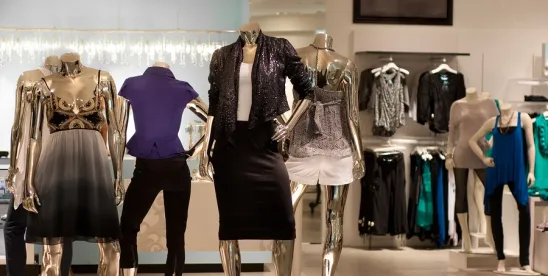As challenging global market conditions linger, fashion brands and retailers in need of liquidity are exploring ways to extract cash from their brand portfolios without divesting entirely. In this article, we consider a popular approach in corporate transactions in the UK fashion industry.
For UK fashion, the past decade has been a hard sell.
After booming from 2020 to 2021, online-only fashion businesses are facing a surprising post-COVID return to the high street by UK consumers. 2024 has seen continued pressure on the UK fashion industry, from high interest rates to high inflation throughout and increasing competition between the high street and online-only retailers and brands. Many businesses are experiencing slow or non-existent growth. In addition, declining sales in key Asian markets are causing concern for luxury fashion brands.
The relatively high cash flow needs of fashion businesses make them especially vulnerable to these macro conditions. The high-profile administrations (roughly equivalent to US bankruptcy proceedings) of Muji and Matches (amongst others) in the year to date illustrate the challenges facing the fashion market across the high-street and luxury sectors.
The sale-and-license-back concept
In these economic conditions, liquidity is both crucial and increasingly hard to come by. To bridge the liquidity gap, some brands are embracing a sale and lease-back structure, in which the seller sells intellectual property related to a brand and is, upon closing, immediately granted a license by the buyer to continue to design, manufacture and/or sell products using that intellectual property.
These deals generally incorporate the sale of intellectual property assets into a joint venture, with the seller retaining an interest in the jointly-owned entity and obtaining a license for certain intellectual property rights to continue to operate (wholly or partly) the business associated with the brand. This structure allows fashion businesses or brand owners to improve balance sheet health and access much-needed cash.
In addition, the accompanying license to design, distribute and/or manufacture products using the sold intellectual property allows the seller to continue to operate the business of the brand, or parts of it that remain profitable (or potentially profitable), following the conclusion of the transaction. Crucially, this means that beyond the payment of royalties, sellers are not required to sacrifice the income from their operation of the brand in question.
This allows for a business-as-usual approach to the day-to-day management of the parts of the brand's business operating under the new license. It also allows the seller to put the newly obtained capital to good use elsewhere in the business — for example, by paying down existing debt, improving general liquidity or funding future turnaround plans.
In a fashion market characterized by varied and wide-ranging challenges, the sale-and-license-back deal structure may represent a mutually beneficial approach for investors and brand operators alike.




 />i
/>i
